
The Incredible String Band were a British psychedelic folk band formed by Clive Palmer, Robin Williamson and Mike Heron in Edinburgh in 1966. Following Palmer's early departure, Williamson and Heron continued as a duo and were eventually augmented by other musicians such as Licorice McKechnie, Rose Simpson, and Malcolm Le Maistre. The band split up in 1974. They reformed in 1999 and continued to perform with changing lineups until 2006.
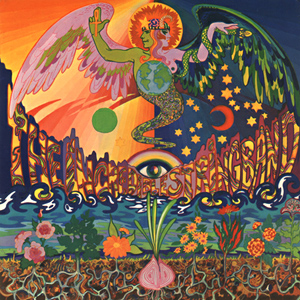
The 5000 Spirits or the Layers of the Onion is the second album by the Scottish psychedelic folk group the Incredible String Band (ISB). It was released in July 1967 on Elektra Records. The album was recorded following the reformation of the band as a duo consisting of Robin Williamson and Mike Heron. Notably, the album was a change in musical direction for the two as they transitioned from their more conventional folk music structures into complex psychedelic compositions influenced by British folk and Indian music.

The Incredible String Band is the debut album by The Incredible String Band, released in the United Kingdom in October 1966 by record label Elektra. It is the only one of the band's albums to feature the original trio line-up with Clive Palmer, Robin Williamson and Mike Heron.

Cripple Crow is the fifth album by American-Venezuelan psychedelic folk musician Devendra Banhart released on September 13, 2005 on XL Recordings. It was his first release on the label XL Recordings. The cover references the Sgt. Pepper's Lonely Hearts Club Band album cover.

U is a double album, the seventh studio album overall, by the British psychedelic folk group the Incredible String Band (ISB) and was released on Elektra Records in October 1970. The majority of the material featured on the album was taken from the mixed-media production of the same name, which saw the band backed by the dancing troupe the Stone Monkey. The concept of U derived from the ISB's fascination and subsequent conversion to Scientology in 1969.
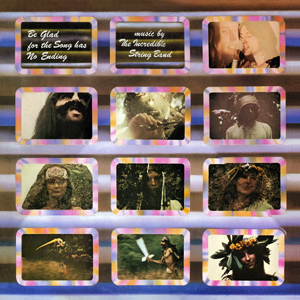
Be Glad for the Song Has No Ending is the eighth album by the Scottish psychedelic folk group, the Incredible String Band, featuring Mike Heron, Robin Williamson, Licorice McKechnie and Rose Simpson. It is the soundtrack for a film of the same name, and was released on Island Records in March 1971, failing to chart in either the UK or US. It would be the first album from the band on the Island label, and the last to feature Joe Boyd as the producer.

Wee Tam and the Big Huge is the fourth album by the Scottish psychedelic folk group the Incredible String Band, released in 1968 by Elektra Records as both a double LP and separate single LPs known individually as Wee Tam and The Big Huge.

James Michael Heron is a Scottish singer, songwriter and multi-instrumentalist, best known for his work in the Incredible String Band in the 1960s and 1970s.

Changing Horses is the fifth album by the Scottish psychedelic folk group, the Incredible String Band (ISB), and was released in November 1969 on Elektra Records. The album saw the group continuing their use of unique instruments while integrating a standard musical structure. In addition, the album is seen as a transitional period in which the ISB shifted in musical textures, including early utilization of electric-based instruments.
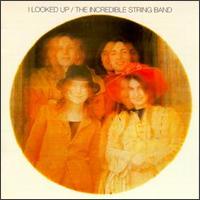
I Looked Up is the sixth album by the Incredible String Band. Recorded at a time when the band was busy rehearsing for their ambitious upcoming stage show, U, the album has been described by band member Robin Williamson as a "quickie" album.

Robin Duncan Harry Williamson is a Scottish multi-instrumentalist, singer, songwriter, and storyteller who was a founding member of the Incredible String Band.
Clive Harold Palmer was an English folk musician and banjoist, best known as a founding member of the Incredible String Band.
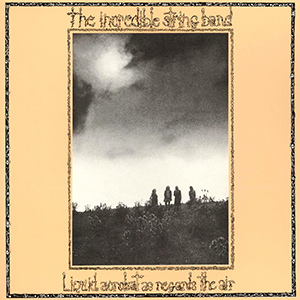
Liquid Acrobat as Regards the Air is the ninth album by the Incredible String Band. It features Mike Heron, Robin Williamson, Licorice McKechnie and Malcolm Le Maistre. The album was the band's first almost entirely electric recording; a new feature that was to define the change in the band's sound throughout their final period through 1974.

Smiling Men with Bad Reputations is the 1971 solo debut album by Mike Heron of the Incredible String Band (ISB).
Malcolm Le Maistre is an English musician, experimental artist and theatre director, who was a member of the Incredible String Band in the 1970s.

Earthspan is the tenth album by The Incredible String Band, released in 1972 on Island Records. It features Mike Heron, Robin Williamson, Licorice McKechnie, and Malcolm Le Maistre.
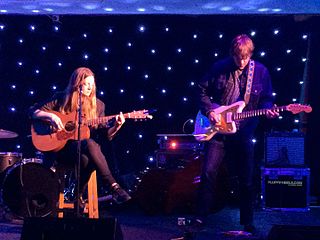
Meg Baird is an American musician based in San Francisco, California, United States, who, in addition to her solo career, is known as a founding member, lead vocalist, and drummer for Heron Oblivion, along with members from Assemble Head in Sunburst Sound and Comets on Fire. She was also a guitarist and the lead female vocalist in Philadelphia psychedelic folk rock band Espers, and played drums in Philadelphia punk band Watery Love. Baird frequently collaborates with the Los Angeles-based harpist Mary Lattimore.
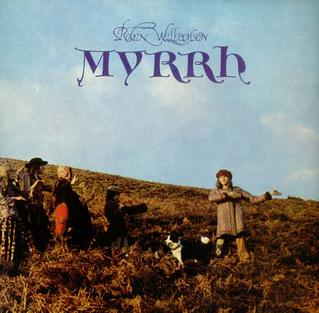
Myrrh is a folk album and the solo debut of Robin Williamson, released in 1972. Robin Williamson is noted as being a founding member of The Incredible String Band. Myrrh was subjected to a low budget and placed on the Island label's lowest sub-label, Help. The album was downgraded by poor-quality sound mixing and a single-sleeve cover design.

Songs For Children of All Ages is a folk album released in 1987 by Robin Williamson. The album was released in 1987 on the Flying Fish label and on Cladagh Records. It was re-issued with Winter's Turning in 1999 on Pig's Whisker Music.
"A Very Cellular Song" is a song by the Incredible String Band, written by Mike Heron, released on the 1968 album The Hangman's Beautiful Daughter.


















